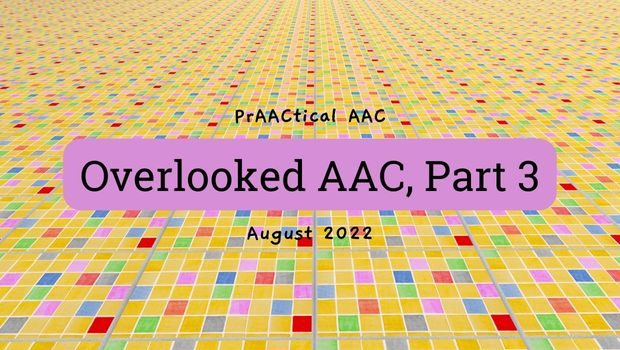Overlooked AAC, Part 3

There are a lot of aspects of AAC service provision, and usually not enough time to address all the things that need to be done. In today’s post, we continue the conversation of things that often take a back seat in AAC services, hoping that it inspires a few of you to action. This time our focus is transitions.
Going to nursery or preschool for the first time. Moving from one teacher or therapist to another. Exiting the school system. Transitions always seem to bring a little extra anxiety and a few additional bumps in the road. Here are some things that make some of those changes go a little more smoothly.
Entering a New Environment
- Prepare the individual: Explain what will be happening. Use visual supports, like a picture schedule or calendar, to show when the transition will occur. Keep it in a visible spot and review it periodically leading up to ‘the big day.’ Role play and rehearsal can be helpful, too.
- Add relevant vocabulary and images to the SGD/AAC app. Review the existing set of words available and consider including additional:
- Names, i.e., appropriate for the new environment, teachers, and school staff;
- Verbs (e.g., wait, line up);
- Nouns (e.g., school bus, cafeteria, backpack, lunchbox);
- Interjections and age-appropriate sayings/slang;
- Greetings and introductions (e.g., “Hi. My name is __. What’s your name?”);
- Personal information (e.g., “I live in Whispering Pines.” “I’m 7 years old. My birthday is in October.”);
- Activity names, such as circle time, recess, and centers;
- Locations (e.g., cafeteria, playground, ball court, media room);
- Time-related words (e.g., later, tomorrow, hurry); and,
- Words or prestored messages for participating in routines (e.g., Pledge of Allegiance, roll call, classroom chants/cheers, Calendar Time).
- Train key communication partners on facilitative strategies, such as understanding multimodal communication, using adequate pause time, and descriptive talking.
- Train personnel on physical management, health, and safety issues.
- Ensure that there is a plan for trained personnel to set up, monitor, and maintain the AAC device in the new environment. Don’t forget about mounting equipment, alternative access tools (e.g., switches, head pointer), charging equipment, & backup batteries.
- Create at-a-glance materials to show the proper operation of key equipment and implementation of important procedures (e.g., wheelchair transfers, removing device and switch mounts).
- Let the client and family know exactly what support you provided to the new team to inform their expectations. This will also help them hold the new team accountable for implementing things in ways that will benefit the AAC user.
- Make a plan for how you will say goodbye in a way that is helpful to the client/student. Be honest and forthright about upcoming separations. Consider marking the transition with a ritual (e.g., ‘graduating’ from XYZ Therapy Services, ringing a bell used to mark special achievements) and/or gifting a transition object or token of remembrance.
Handoff to a New Teacher or Therapist
- Initiate contact with the receiving professional(s) to provide key information and answer questions. Try to get a sense of how AAC-friendly the new environment is and adjust your support accordingly.
- Consider creating materials that will prepare the receiving professional to serve the individual (e.g., “About Me”, communication passport, SLP Guide to __’s AAC System).
- Ensure that there is a plan for the new teacher/therapist to obtain detailed information and/or training on how the individual communicates and how partners should (and should NOT) respond.
- Provide guidance on and documentation for any AAC and related equipment, including things like contact information for SGD company, serial number, and operating manual. Let them know where to go for help if they run into problems or have questions.
- Suggest resources for device training (e.g., vendor representative, YouTube links).
- Provide information on device backups.
- Discuss best practices for making changes to the device.
- Consider making yourself available for follow-up questions during the early days of the transition. A phone conversation or Zoom session might make a big difference in helping them support the AAC user.
Discharging from Service
- School-owned equipment to client-owned equipment: When you know that a student is leaving the school system and uses school-funded AAC equipment, start planning a year in advance to ensure that access to appropriate AAC is not interrupted. For example, we can work with the family to evaluate the student and pursue SGD purchase with health insurance funding (e.g., Medicaid, private insurance).
- Help to identify alternative sources of AAC services, if appropriate and possible.
- Consider teaching the student/client more about their SGD operations (e.g., adding new vocabulary, removing symbols, backup procedures).
- Double down on training parents and other communication partners.
- Document these activities in the individual’s file and/or Plan of Care.
Do you have other suggestions for us to consider during times of transition? We’d love to hear about them.
You can see the first two posts in this series here: Part 1, Part 2.
Filed under: Featured Posts, PrAACtical Thinking
This post was written by Carole Zangari
